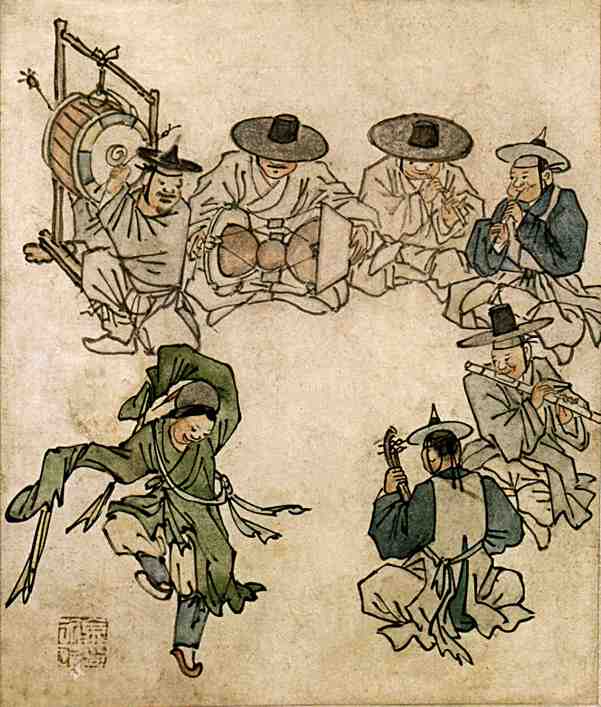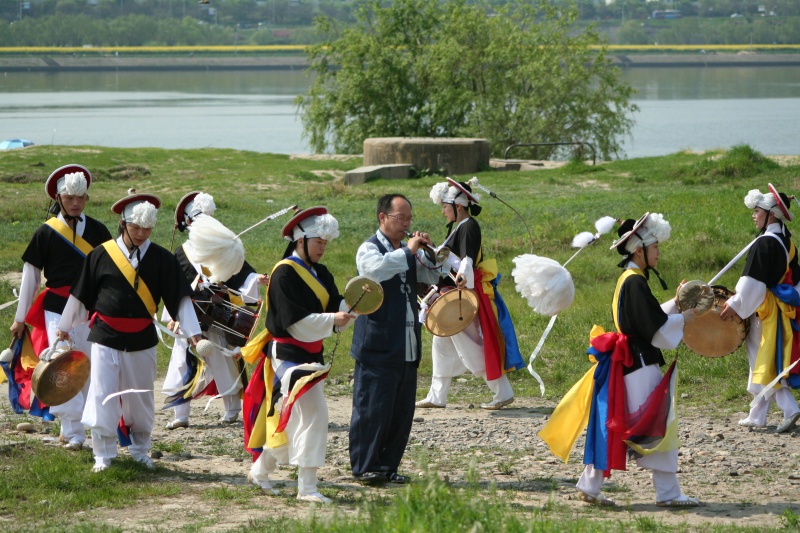|
Korean Barrel Drum
The Korean barrel drum is a shallow, barrel-shaped drum used in several types of Korean music, one of the many traditional Korean drums. This variety of drum has a round wooden body that is covered on both ends with animal skin. They are categorized as ''hyekbu'' (혁부, ) which are instruments made with leather, and have been used for '' jeongak'' (Korean court music) and folk music. History The barrel drums used for court music are usually fixed with nails on the rims, while ones used for folk music are usually tied up with leather straps to form the shape. Performers in the court music usually beat these drums with a single drumstick (called ''bukchae'', 북채) in one hand or two hands together, while drummers in the folk music commonly use a drumstick in their right hand while hitting the other side with their open left hand. In the past, the ''jong'' (종, bell) was also referred to as "''soebuk''" (쇠북, metal drum) and included in the drum category. Barrel drums have ... [...More Info...] [...Related Items...] OR: [Wikipedia] [Google] [Baidu] |
Bipa
The ''bipa'' is a pear-shaped lute that is a traditional Korean musical instrument. It is derived from Chinese ''pipa'' and was introduced through the Silk Road to Goguryeo and Silla. There are two major types of ''bipa'': the four stringed ''dang-bipa'' (당비파 / 唐琵琶) and the five stringed ''hyang-bipa'' (향비파 / 鄕琵琶). While ''dang-bipa'' was a Tang-style pipa first introduced from the Chinese Tang dynasty and localized over time to have Korean characteristics, ''hyang-bipa'' was created in the Korean Kingdom of Silla. The instrument is also related to other derivatives such as Vietnamese '' đàn tỳ bà'' and the Japanese ''biwa''. The bipa was popular in court music until it fell out of use in the early 20th century during the Japanese Colonial period. In 1988–1989, there was the first attempt to revive the two ''bipa'' that was unsuccessful in commercialization. This revived ''bipa'' used the existing modern Chinese pipa as a basis but was modified to ... [...More Info...] [...Related Items...] OR: [Wikipedia] [Google] [Baidu] |
Pungmul
''Pungmul'' (; ) is a Korean folk music tradition that includes drumming, dancing, and singing. Most performances are outside, with dozens of players all in constant motion. ''Pungmul'' is rooted in the ''dure'' (collective labor) farming culture. It was originally played as part of farm work, on rural holidays, at other village community-building events, and to accompany shamanistic rituals, mask dance dramas, and other types of performance. During the late 1960s and 1970s it expanded in meaning and was actively used in political protest during the pro-democracy movement, although today it is most often seen as a performing art. Older scholars often describe this tradition as ''nongak'' (), a term meaning "farmers' music" whose usage arose during the colonial era (1910–1945). The Cultural Heritage Administration of South Korea uses this term in designating the folk tradition as an Important Intangible Cultural Property. Opposition from performers and scholars toward its u ... [...More Info...] [...Related Items...] OR: [Wikipedia] [Google] [Baidu] |
Nongak
''Pungmul'' (; ) is a Korean folk music tradition that includes drumming, dancing, and singing. Most performances are outside, with dozens of players all in constant motion. ''Pungmul'' is rooted in the ''dure'' (collective labor) farming culture. It was originally played as part of farm work, on rural holidays, at other village community-building events, and to accompany shamanistic rituals, mask dance dramas, and other types of performance. During the late 1960s and 1970s it expanded in meaning and was actively used in political protest during the pro-democracy movement, although today it is most often seen as a performing art. Older scholars often describe this tradition as ''nongak'' (), a term meaning "farmers' music" whose usage arose during the colonial era (1910–1945). The Cultural Heritage Administration of South Korea uses this term in designating the folk tradition as an Important Intangible Cultural Property. Opposition from performers and scholars toward its usag ... [...More Info...] [...Related Items...] OR: [Wikipedia] [Google] [Baidu] |
Pansori
'''' () is a Korean genre of musical storytelling performed by a singer and a drummer. The term ''pansori'' is derived from the Korean words ''pan'' (Hangul: 판) and ''sori'' (Hangul: 소리), the latter of which means "sound." However, ''pan'' has multiple meanings, and scholars disagree on which was the intended meaning when the term was coined. One meaning is "a situation where many people are gathered." Another meaning is "a song composed of varying tones." In music, Gugwangdae describes a long story that takes as little as three hours and as much as eight hours or more. It is one of the traditional forms of Korean music that mixes body movements and songs to the accompaniment of a buk drum played by a gosu. The dramatic content of the drama is changed according to various rhythms based on the melody of Korea's local music. Pansori was originally called the "sori", and it was called Taryeong, Japga (잡가), Clown Song, and Geukga (극가; 劇歌). It was also commonly use ... [...More Info...] [...Related Items...] OR: [Wikipedia] [Google] [Baidu] |
Namsadang
The ''namsadang'' () is a Korean itinerant troupe which consists of male performers who present various performing arts such as acrobatics, singing, dancing and playing like a circus. It is said that ''namsadang'' was spontaneously formed before 1900 during the Joseon Dynasty and used to wander about marketplaces and villages. The troupe was considered the lowest class in society along with ''cheonmin'' (vulgar commoners) or ''baekjeong'' (butchers), so that very few historical documents remain on them. However, since a record that a puppet show was performed during the Silla period (57 BCE – 935 CE) has been found, it is assumed that similar types of itinerant companies appeared in Korean history a long time ago. During the late Joseon Dynasty, there were several ''namsadang'', but the one whose base was set in Cheongryongsa temple (청룡사) in Anseong, Gyeonggi Province was the most famous. They became called ''namsadang'' because the troupe were composed of only men an ... [...More Info...] [...Related Items...] OR: [Wikipedia] [Google] [Baidu] |
Janggu
The ''janggu'' (, also transliterated as ''janggo'' or ''changgo'') or sometimes called ''seyogo'' (slim waist drum) is the most representative drum in traditional Korean music. It is available in most kinds, and consists of an hourglass-shaped body with two heads made from animal skin. The two heads produce sounds of different pitch and timbre, which when played together are believed to represent the harmonious joining of Um and Yang. The janggu is one of the four components of samul nori (사물놀이), alongside the buk (북), jing (징) and kkwaenggwari (꽹과리). History The earliest depictions of the instrument were inscribed on a bell belonging to the Silla (57 BC–935 AD) period and in a mural painting of the same period in Goguryeo (37 BC–668 AD) tomb. The oldest written records about an hourglass-shaped drum may be traced to the reign of King Munjong (1047–1084) of Goryeo as a field instrument. The Korean record from 1451 titled ''Goryeo-sa'', or History of ... [...More Info...] [...Related Items...] OR: [Wikipedia] [Google] [Baidu] |
China
China, officially the People's Republic of China (PRC), is a country in East Asia. It is the world's most populous country, with a population exceeding 1.4 billion, slightly ahead of India. China spans the equivalent of five time zones and borders fourteen countries by land, the most of any country in the world, tied with Russia. Covering an area of approximately , it is the world's third largest country by total land area. The country consists of 22 provinces, five autonomous regions, four municipalities, and two Special Administrative Regions (Hong Kong and Macau). The national capital is Beijing, and the most populous city and financial center is Shanghai. Modern Chinese trace their origins to a cradle of civilization in the fertile basin of the Yellow River in the North China Plain. The semi-legendary Xia dynasty in the 21st century BCE and the well-attested Shang and Zhou dynasties developed a bureaucratic political system to serve hereditary monarchies, or dyna ... [...More Info...] [...Related Items...] OR: [Wikipedia] [Google] [Baidu] |
Dangak
''Dangak'' (syllables: ''dang-ak'') is a genre of traditional Korean court music. The name means "Tang music", and the style was first adapted from Tang Dynasty Chinese music during the Unified Silla period in the late first millennium. It was continued through the Goryeo (918–1392) and Joseon (1392–1910) dynasties, when, along with ''hyangak'' and ''aak'' it was one of the three approved genres of court music. ''Dangak'' performances were accompanied by Tang-style dances known as ''dangak jeongjae''. Together with ''hyangak'', during the Joseon Dynasty ''dangak'' performances were the charge of the ''Jeonakseo'' (hangul: 전악서; hanja: 典 樂 署; 1394–1457) and later of the Jangagwon (hangul: 장악원; hanja: 掌 樂 院), the court office of music. Performers of ''hyangak'' and ''dangak'' were drawn from the lower classes, in contrast to performers of ''aak''. One of the most famous pieces in the ''dangak'' repertoire is called ''Nakyangchun'' (hangul: 낙양 ... [...More Info...] [...Related Items...] OR: [Wikipedia] [Google] [Baidu] |
Goryeo
Goryeo (; ) was a Korean kingdom founded in 918, during a time of national division called the Later Three Kingdoms period, that unified and ruled the Korean Peninsula until 1392. Goryeo achieved what has been called a "true national unification" by Korean historians as it not only unified the Later Three Kingdoms but also incorporated much of the ruling class of the northern kingdom of Balhae, who had origins in Goguryeo of the earlier Three Kingdoms of Korea. The name "Korea" is derived from the name of Goryeo, also spelled Koryŏ, which was first used in the early 5th century by Goguryeo. According to Korean historians, it was during the Goryeo period that the individual identities of Goguryeo, Baekje, and Silla were successfully merged into a single entity that became the basis of modern-day 'Korean' identity. Throughout its existence, Goryeo, alongside Unified Silla, was known to be the "Golden Age of Buddhism" in Korea. As the state religion, Buddhism achieved its highes ... [...More Info...] [...Related Items...] OR: [Wikipedia] [Google] [Baidu] |
Doosan Encyclopedia
''Doosan Encyclopedia'' is a Korean language encyclopedia published by Doosan Donga (두산동아). The encyclopedia is based on the ''Dong-A Color Encyclopedia'' (동아원색세계대백과사전), which comprises 30 volumes and began to be published in 1982 by Dong-A Publishing (동아출판사). Dong-A Publishing was merged into Doosan Donga, a subsidiary of Doosan Group, in February 1985. The ''Doosan Encyclopedia'' is a major encyclopedia in South Korea. Digital edition EnCyber The online version of the ''Doosan Encyclopedia'' was named EnCyber, which is a blend of two English words: ''Encyclopedia'' and ''Cyber''. The company has stated that, with the trademark, it aims to become a center of living knowledge. EnCyber provides free content to readers via South Korean portals such as Naver. Naver has risen to the top position in the search engine market of South Korea partially because of the popularity of EnCyber encyclopedia. When Naver exclusively contracted Doosan Do ... [...More Info...] [...Related Items...] OR: [Wikipedia] [Google] [Baidu] |

.jpg)




